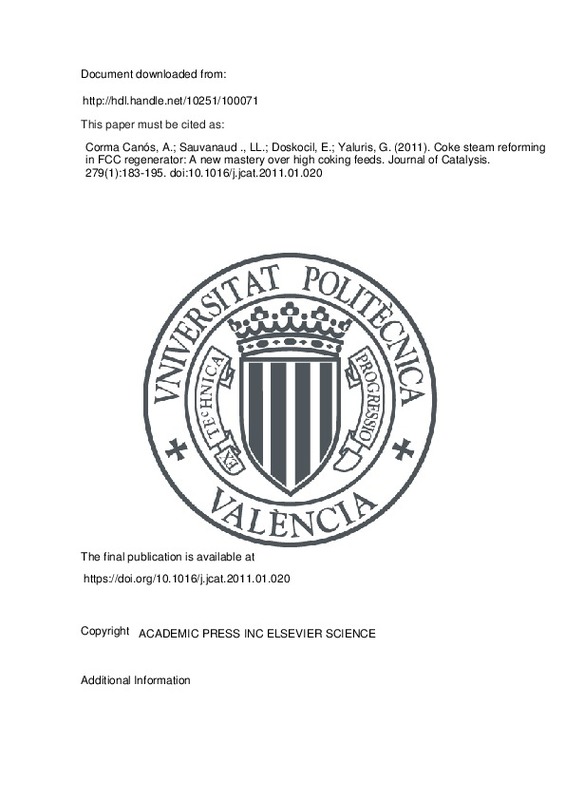JavaScript is disabled for your browser. Some features of this site may not work without it.
Buscar en RiuNet
Listar
Mi cuenta
Estadísticas
Ayuda RiuNet
Admin. UPV
Coke steam reforming in FCC regenerator: A new mastery over high coking feeds
Mostrar el registro sencillo del ítem
Ficheros en el ítem
| dc.contributor.author | Corma Canós, Avelino
|
es_ES |
| dc.contributor.author | Sauvanaud ., Laurent L.A.
|
es_ES |
| dc.contributor.author | Doskocil, Eric
|
es_ES |
| dc.contributor.author | Yaluris, George
|
es_ES |
| dc.date.accessioned | 2018-04-08T04:20:47Z | |
| dc.date.available | 2018-04-08T04:20:47Z | |
| dc.date.issued | 2011 | es_ES |
| dc.identifier.issn | 0021-9517 | es_ES |
| dc.identifier.uri | http://hdl.handle.net/10251/100071 | |
| dc.description.abstract | [EN] One of the crucial problems of processing residual feeds in the FCC is their high coking tendency, which limits their use in the FCC and requires them to be mixed with lighter feeds to be processed in conventional FCC units. A step-out improvement of the FCC process to use in processing heavy feeds is presented, where the heat balance in the unit is maintained by removing the high coke-on-catalyst by a combination of coke combustion and reforming, i.e., coke steam reforming (CSR) in the regenerator. This option enables using feeds with more than 10% Conradson Carbon while still maintaining the possibility to control the heat balance in the unit without using partial combustion or catalyst coolers. Although the Equilibrium catalyst has little CSR activity, we have found that hydrotalcite materials, besides having an excellent catalytic cracking selectivity for heavy feeds, also have significant CSR activity. We have demonstrated that CSR can be performed together with combustion at conditions found in the FCC regenerator so that the regenerator temperature remains within traditional limits despite higher coke-on-catalyst, and the coke on the catalyst is nearly completely removed. While the reaction rate at higher temperatures seems to obey first order, steam reforming coke removal kinetics at lower (750 degrees C) temperatures seem more complex due to the heterogeneous nature of coke. | es_ES |
| dc.description.sponsorship | The authors thank BP Products North America and Consolider-Ingenio 2010 (MULTICAT project) for their financial support and permission to publish this work. | en_EN |
| dc.language | Inglés | es_ES |
| dc.publisher | ACADEMIC PRESS INC ELSEVIER SCIENCE | es_ES |
| dc.relation.ispartof | Journal of Catalysis | es_ES |
| dc.rights | Reserva de todos los derechos | es_ES |
| dc.subject | Hydrotalcite | es_ES |
| dc.subject | Steam reforming | es_ES |
| dc.subject | Catalytic cracking | es_ES |
| dc.subject.classification | QUIMICA ORGANICA | es_ES |
| dc.title | Coke steam reforming in FCC regenerator: A new mastery over high coking feeds | es_ES |
| dc.type | Artículo | es_ES |
| dc.identifier.doi | 10.1016/j.jcat.2011.01.020 | es_ES |
| dc.relation.projectID | info:eu-repo/grantAgreement/MICINN//CSD2009-00050/ES/Desarrollo de catalizadores más eficientes para el diseño de procesos químicos sostenibles y produccion limpia de energia/ | es_ES |
| dc.rights.accessRights | Abierto | es_ES |
| dc.contributor.affiliation | Universitat Politècnica de València. Departamento de Química - Departament de Química | es_ES |
| dc.description.bibliographicCitation | Corma Canós, A.; Sauvanaud ., LL.; Doskocil, E.; Yaluris, G. (2011). Coke steam reforming in FCC regenerator: A new mastery over high coking feeds. Journal of Catalysis. 279(1):183-195. https://doi.org/10.1016/j.jcat.2011.01.020 | es_ES |
| dc.description.accrualMethod | S | es_ES |
| dc.relation.publisherversion | https://doi.org/10.1016/j.jcat.2011.01.020 | es_ES |
| dc.description.upvformatpinicio | 183 | es_ES |
| dc.description.upvformatpfin | 195 | es_ES |
| dc.type.version | info:eu-repo/semantics/publishedVersion | es_ES |
| dc.description.volume | 279 | es_ES |
| dc.description.issue | 1 | es_ES |
| dc.relation.pasarela | S\198232 | es_ES |
| dc.contributor.funder | Ministerio de Ciencia e Innovación | es_ES |







![[Cerrado]](/themes/UPV/images/candado.png)

